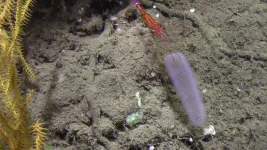(Press-News.org) Scientists have developed a new "key-hole surgery" technique to extract metals from the earth - which could revolutionise the future of metal mining
A team of international researchers, including Dr Rich Crane from the Camborne School of Mines, University of Exeter, have developed a new method to extract metals, such as copper, from their parent ore body.
The research team have provided a proof of concept for the application of an electric field to control the movement of an acid within a low permeability copper-bearing ore deposit to selectively dissolve and recover the metal in situ.
This is in contrast to the conventional approach for the mining of such deposits where the material must be physically excavated, which requires removal of both overburden and any impurities within the ore (known as gangue material).
The researchers believe the new technique has the potential to transform the mining industry, because it has the capability to dissolve metals from a wide range of ore deposits that were previously considered inaccessible.
Furthermore, due to the non-invasive nature of the extraction, the research team are hopeful that the study will help usher in a more sustainable future for the industry.
This is urgently required now in order to provide the plethora of metals required to deliver green technology, such as renewable energy infrastructure and electrified vehicles, whilst limiting any potential environmental damage associated with the mining of such vitally important metals.
The study was recently published in Science Advances.
Dr Rich Crane from the Camborne School of Mines, University of Exeter, and co-author of the study, said: "This new approach, analogous to "key-hole surgery", has the potential to provide a more sustainable future for the mining industry, by enabling the recovery of metals, such as copper, which are urgently needed for our global transition to a new Green Economy, whilst avoiding unwanted environmental disturbance and energy consumption."
The central principle behind most modern mining techniques has not fundamentally changed since their original conception, which marked the beginning of the Bronze Age: metals are recovered from the subsurface via physical excavation, i.e., the construction of tunnels to gain access to the deposits, or by creating "open cast" mines.
This technique demands large volumes of surface soil, overburden and gangue material to also be excavated, which can contain millions of tonnes of material - and can also lead to habitat destruction.
In this new publication, experts from the University of Western Australia, the Commonwealth Scientific and Industrial Research Organisation (CSIRO), the Technical University of Denmark and the University of Exeter, have demonstrated that a targeted electric field can be used to dissolve and then recover copper in situ from the ore - avoiding any requirement to physically excavate the material.
This new technology comprises the construction (drilling) of electrodes directly into an ore body. An electric current is then applied which can result in the transport of electrically charged metal ions, such as copper, through the rock via a process called electromigration.
The research team have now provided a Proof of Concept for this new technology at laboratory scale, which has also been verified using computer modelling. They are confident that the idea will work beyond the laboratory-scale.
INFORMATION:
Swansea University scientists have uncovered potentially dangerous chemical pollutants that are released from disposable face masks when submerged in water.
The research reveals high levels of pollutants, including lead, antimony, and copper, within the silicon-based and plastic fibres of common disposable face masks.
The work is supported by the Institute for Innovative Materials, Processing and Numerical Technologies (IMPACT) and the SPECIFIC Innovation & Knowledge Centre
Project lead Dr Sarper Sarp of Swansea University College of Engineering said:
"All of us need to keep wearing masks as they are essential in ending the pandemic. But we also urgently need more research and regulation on mask production, so we can reduce any risks to the environment and ...
Pyrosomes, named after the Greek words for 'fire bodies' due their bright bioluminescence, are pelagic tunicates that spend their entire lives swimming in the open ocean. They are made up of many smaller animals, known as zooids, that sit together in a tubular matrix, known as tunic (hence the name pelagic tunicates). Because they live in the open ocean, they generally go unnoticed. In spite of this, increasing research points to their importance in marine environments, as they can form dense blooms that impact food web dynamics and contribute to the movement and transformation of organic carbon.
The study conducted with GEOMAR research vessel POSEIDON in 2018 and 2019 in the vicinity of the Cabo Verde Islands, of which the results have now been published ...
Scientists at the Walter Reed Army Institute for Research demonstrated that biomarkers associated with traumatic brain injury were elevated among law enforcement and military personnel, particularly in active duty participants with longer duration of service. Most notably, these elevated biomarker levels were observed in individuals without a diagnosed brain injury or concussion.
Some law enforcement and military personnel are regularly exposed to low levels of blast, particularly during training, due to the use of explosive charges and high caliber weapons. Understanding effects from these occupational exposures is a military health care priority to improve ...
FAYETTEVILLE, Ark. - A new map including rover paths of the Schrodinger basin, a geologically important area of the moon, could guide future exploration missions.The map was created by a team of interns at the Lunar and Planetary Institute, including Ellen Czaplinski, a University of Arkansas graduate student researcher at the Arkansas Center for Planetary Sciences and first author of a paper published in The Planetary Science Journal.
The researchers identified significant geologic features of the Schrödinger basin, located near the lunar south ...
Researchers at the U.S. Department of Energy's National Renewable Energy Laboratory (NREL) developed a breakthrough in energy-efficient phototransistors. Such devices could eventually help computers process visual information more like the human brain and be used as sensors in things like self-driving vehicles.
The structures rely on a new type of semiconductor--metal-halide perovskites--which have proven to be highly efficient at converting sunlight into electrical energy and shown tremendous promise in a range of other technologies.
"In general, these perovskite semiconductors are a really unique ...
Hypertension is a common medical condition and a primary cause of cardiovascular diseases and stroke worldwide. Unfortunately, as Professor Wei-Li Zhang of the Chinese National Center for Cardiovascular Diseases notes, "the unaffordability of drugs is a major barrier to medication adherence among patients living in low- and middle-income areas."
One of the countries where hypertension is becoming a major problem is China where, researchers estimate, between 244 million and 300 million adults are living with hypertension. But true to Prof. Zhang's words, most cases of hypertension in China are not adequately ...
With the explosion in digital entertainment options over the past several decades and the more recent restrictions on outdoor and in-person social activities, parents may worry that excessive engagement with digital technology could have long-term effects on their children's mental health.
A new study published in the journal Clinical Psychological Science, however, found little evidence for an increased association between adolescents' technology engagement and mental health problems over the past 30 years. The data did not consistently support the suggestion that the technologies we worry about most (e.g., smartphones) are becoming more ...
DURHAM, N.C. - When patients complain of coughing, runny nose, sneezing and fever, doctors are often stumped because they have no fundamental tool to identify the source of the respiratory symptoms and guide appropriate treatments.
That tool might finally be on its way. In a study proving feasibility, researchers at Duke Health showed that their testing technology can accurately distinguish between a viral and a bacterial infection for respiratory illness - a critical difference that determines whether antibiotics are warranted. And, importantly, the test provided results in under an hour.
"This is exciting progress," said study lead Ephraim Tsalik, associate professor in the departments of Medicine ...
A new study published in Medical Care Research and Review found that the Affordable Care Act, which expanded Medicaid programs to cover people previously uninsured, provided a financial boost to hospitals.
The study conducted by faculty at the Colorado School of Public Health on the University of Colorado Anschutz Medical Campus is the first to investigate the effects of Medicaid expansion by comparing estimates using data from both the Internal Revenue Service (IRS) and the Centers for Medicare and Medicaid Services (CMS).
"The IRS and CMS data sources serve as primary resources for assessing the impact of Medicaid expansion on hospitals' financial status. The comparison of the two is timely and can inform ...
BOSTON - Researchers at Massachusetts General Hospital (MGH) have identified the protein "signature" of severe COVID-19, which they describe in a new study published in Cell Reports Medicine. "We were interested in asking whether we could identify mechanisms that might be contributing to death in COVID-19," says MGH infectious disease expert Marcia Goldberg, MD, who studies interactions between microbial pathogens and their hosts, and is senior author of the study. "In other words, why do some patients die from this disease, while others--who appear to be just as ill--survive?"
In March 2020, when the first patients with symptoms of COVID-19 ...



